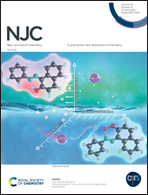In situ aqueous phase hydrodeoxygenation of methyl palmitate on Ni–Co alloy particles embedded in mesoporous carbon hollow sphere catalysts†
Abstract
Herein, Ni–Co alloy particles embedded in mesoporous carbon hollow sphere (MCHS) catalysts were prepared by the one-pot Stöber method using SiO2 as a hard template and resorcinol–formaldehyde (RF) resin as a carbon source, and they were tested for in situ aqueous phase hydrodeoxygenation of methyl palmitate to hydrocarbons using methanol as a hydrogen donor. The formation of the catalyst precursors involves nucleation, growth and co-assembly of RF and SiO2. The introduction of SiO2 can facilitate the construction of the mesoporous and hollow structure and improve the specific surface area. It also reduces the micropore volume due to the reduced graphitization degree of the catalysts induced by SiO2. Thus, the internal diffusion resistance is decreased. Particularly, the Ni–Co alloy particles formed during carbonization are embedded in the mesoporous carbon layer, effectively hindering their sintering and leaching under the harsh hydrothermal conditions. Moreover, the metal sites can be exposed on both mesoporous channels and inner/outer surfaces of the carbon hollow spheres, making the reactants easily accessible. In the in situ hydrodeoxygenation of methyl palmitate, the as-prepared catalyst gives the pentadecane yield of 89.0% at 310 °C for 1 hour. It is noted that the facile diffusion in MCHSs suppresses the undesired C–C bond hydrogenolysis. The catalyst is not obviously deactivated during five reaction cycles.



 Please wait while we load your content...
Please wait while we load your content...